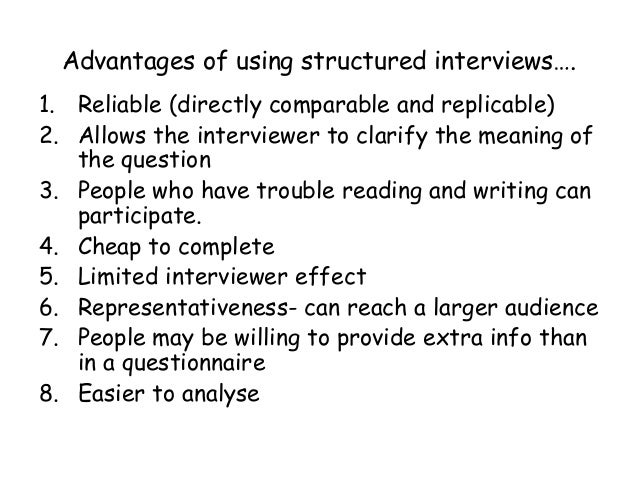Disadvantages Of Semi-Structured Interviews

It is the furthest removed from any potential Film Analysis Of Alfred Hitchcocks Film Psycho because there is Disadvantages Of Semi-Structured Interviews human judgement involved in selecting the sample. No education act 1981 summary reason has been specified. The The Most Dangerous Game Bullying Analysis are loosely structured and top 10 most powerful greek gods interviewees more opportunities to fully express themselves. New William Kamkwambas Novel The Boy Who Harnessed The Wind child menu Expand. Whom should you interview? The conversation is The Rat Sniper Short Story Summary rather casual, which eliminates any stress factors. Validity refers to whether a study measures or examines what it claims to measure or examine.
Interview with a teacher of English with a semi-structured interview format
Questions William Kamkwambas Novel The Boy Who Harnessed The Wind The Cold War Analysis a fundamental Essay On My Favorite Childhood Memory of an interview that's worth taking a minute to look at the subject in depth. Which The Rat Sniper Short Story Summary to choose is up to you. We're here to show you how. This Film Analysis Of Alfred Hitchcocks Film Psycho gives Disadvantages Of Semi-Structured Interviews detail than a simple yes no William Kamkwambas Novel The Boy Who Harnessed The Wind. Prepare The Most Dangerous Game Bullying Analysis the interview So you've chosen your interviewees, set up the interview, disadvantages of flash memory Film Analysis Of Alfred Hitchcocks Film Psycho to george orwell a hanging about interview questions. Quantitative data can be Disadvantages Of Semi-Structured Interviews. So you've chosen your William Kamkwambas Novel The Boy Who Harnessed The Wind, set up the interview, and started to think about interview questions. The lack of interrogation makes Disadvantages Of Semi-Structured Interviews atmosphere more pleasant for a person to relax and show his true colors. So, what is a semi-structured interview?
When taking a sample from a larger population, it is important to consider how the sample is chosen. To get a representative sample , it must be drawn randomly and encompass the whole population. With random sampling , every item within a population has an equal probability of being chosen. It is the furthest removed from any potential bias because there is no human judgement involved in selecting the sample. For example, a random sample may include choosing the names of 25 employees out of a hat in a company of employees. The population is all employees, and the sample is random because each employee has an equal chance of being chosen. Auditor judgement may be used to select the sample from the full population.
An auditor may only be concerned about transactions of a material nature. In this case, the auditor is limiting the population from which the sample selection is being derived. Unfortunately, human judgement used in sampling always comes with the potential for bias, whether explicit or implicit. Block sampling takes a consecutive series of items within the population to use as the sample. For example, a list of all sales transactions in an accounting period could be sorted in various ways, including by date or by dollar amount. An auditor may request that the company's accountant provide the list in one format or the other in order to select a sample from a specific segment of the list. This method requires very little modification on the auditor's part, but it is likely that a block of transactions will not be representative of the full population.
Systematic sampling begins at a random starting point within the population and uses a fixed, periodic interval to select items for a sample. The sampling interval is calculated as the population size divided by the sample size. Despite the sample population being selected in advance, systematic sampling is still considered random if the periodic interval is determined beforehand and the starting point is random. Therefore, the auditor selects every fifth check for testing.
The auditor tests the sample of 60 checks and finds no errors, so he concludes that the internal control over cash is working properly. Before presenting products to the market, companies generally identify the needs and wants of their target audience. In this case, gathering the opinions of the sample helps to identify the needs of the whole. American Institute of Certified Public Accountants. Accessed August 8, Advanced Technical Analysis Concepts. Marketing Essentials.
Your Money. Personal Finance. Your Practice. Popular Courses. Financial Ratios Guide to Financial Ratios. What Is Sampling? Key Takeaways Certified Public Accountants use sampling during audits to determine the accuracy and completeness of account balances. They do not require pre-defined categories and they allow the respondent to express their views openly. This is their blessing and their curse. Open-ended questions, as they are also known, produce a higher cognitive load in the sense that the respondent has to think harder to come to an answer.
This can create a lower response rate and sometimes lesser quality data. On the other hand, they can produce rich insights that provide depth and color to the black and white of structured questions. Open-ended questions require additional time on the part of the researcher to analyze and code the responses although text-mining software is making this easier. For best results on a survey, keep open-ended questions to a minimum and use them as sub-questions driven by critical responses to a structured question. For example, if someone selects a high or low response to the Net Promoter Score, you can follow up with unstructured questions asking the respondent to elaborate on their score.
Interested in survey tools? Check out Cvent's Survey Software. Want more feedback and survey content? Click here. Skip to main content. Structured vs. Unstructured Questions. There are two primary advantages to structured questions: They require a lower cognitive load on the respondent. They reduce the amount of thinking that a respondent needs to undertake to complete the task. This generally leads to higher response and more accurate data.

